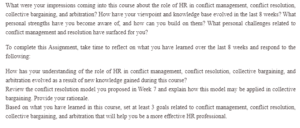The Role of HR in Conflict Resolution and Arbitration
HR’s Role in Conflict Resolution and Collective Bargaining
The human resource department is a mediator, helping solve conflicts between employees and managers. The department also protects employees’ rights against employers’ exploitation. The HR department uses company policies and employment and labor laws to perform this vital role. The department follows strict guidelines and procedures to ensure all parties are satisfied with the mediated outcome (Roche, Teague & Colvin, 2014).
One of the HR department’s essential functions is to respond to employee complaints. Such complaints arise from employees against managers or their colleagues, and they primarily include complaints of unfair treatment, poor working conditions, and common workplace conflicts (Roche, Teague & Colvin, 2014). HR mediates solutions and compromises besides determining appropriate disciplinary action if necessary.
Another key takeaway from the course is the HR department’s litigation role between labor unions and employers. The department tends to be neutral by balancing the interests of employees and employers. HR comes in when employers and labor unions cannot reach compromises on their own.
Additionally, the role of the HR department in the age of increasing allegations of sexual harassment and workplace exploitation cannot be overstated. Whenever such allegations arise, the department is the first stop point. HR investigates the validity of the accusations before applying the relevant equal opportunity standards to solve the issue. If the severity of such allegations is beyond the purview of the HR department, then they assist the victim in filing a formal complaint with the relevant legal system.
Collaboration and Collective Bargaining
According to the International Labor Organization (ILO), collective bargaining is a fundamental right for employees in most workplace environments. Collaboration as a means of conflict resolution can be applied to reaching workplace compromises. For instance, employers and employees can negotiate acceptable working conditions and wages through collective bargaining agreements.
Also, collective bargaining, just like collaboration, provides a basis for founding sound labor relations. Common agenda to bargain for at the workplace includes working hours, salaries and wages, working conditions, occupational safety, and career progression opportunities (International Labor Organization, n.d.). The primary objective in the bargaining process is to reach a negotiated position that complies with predetermined terms and conditions of employment.
The collective bargaining process may also delve into the rights and responsibilities of all parties at the workplace to create a harmonious and productive workplace environment. By ensuring inclusiveness and collaboration, managers eliminate sentiments of inequality in the workplace, besides enhancing employee protection. In the long run, employees feel a sense of belonging, thus zealously pursuing organizational objectives.
Goals during Arbitration and Conflict Resolution
A primary objective in conflict resolution is to clarify what the conflict is. Explaining conflicts is all about getting to the root of the problem by ensuring all parties agree (Lim & Yazdanifard, 2012). As an HR professional, I will achieve this by explaining which needs are not being met by both parties in the conflict to ensure mutual understanding. While at it, it is essential to get the points of view of all parties by asking questions.
Also, all parties involved in an arbitration exercise must agree on the resolution method. If, for instance, the conflict is between colleagues, it is vital to allow them to express their mutually acceptable common ground (Lim & Yazdanifard, 2012). Henceforth, each party should stick to their responsibility to achieve common ground.
Finally, the negotiated resolution should be binding, and all parties must abide by it. Living by the agreed solutions will prevent a recurrence of conflicts. Once a solution is reached, all parties should know they will stick to it.
References
International Labour Organization. (n.d.). Collective bargaining and labor relations (Collective bargaining and labor relations). Www.ilo.org. https://www.ilo.org/global/topics/collective-bargaining-labour-relations/lang–en/index.htm
Liddle, D. (2017). Managing conflict: A practical guide to resolution in the workplace. Kogan Page Publishers.
Lim, J. H., & Yazdanifard, R. (2012). The difference between conflict management styles and conflict resolution in the workplace. Business & Entrepreneurship Journal, 1(1).
Roche, W. K., Teague, P., & Colvin, A. J. (Eds.). (2014). The Oxford handbook of conflict management in organizations. Oxford University Press.
ORDER A PLAGIARISM-FREE PAPER HERE
We’ll write everything from scratch
Question
What were your impressions about the role of HR in conflict management, conflict resolution, collective bargaining, and arbitration coming into this course? How have your viewpoint and knowledge base evolved in the last eight weeks? What personal strengths have you become aware of, and how can you build on them? What unique challenges related to conflict management and resolution have surfaced for you?

The Role of HR in Conflict Resolution and Arbitration
To complete this Assignment, take time to reflect on what you have learned over the last eight weeks and respond to the following:
How has your understanding of the role of HR in conflict management, conflict resolution, collective bargaining, and arbitration evolved as a result of new knowledge gained during this course?
Review the conflict resolution model you proposed in Week 7 and explain how this model may be applied in collective bargaining. Provide your rationale.
Based on what you have learned in this course, set at least three goals for conflict management, conflict resolution, collective bargaining, and arbitration to help you be a more effective HR professional.

